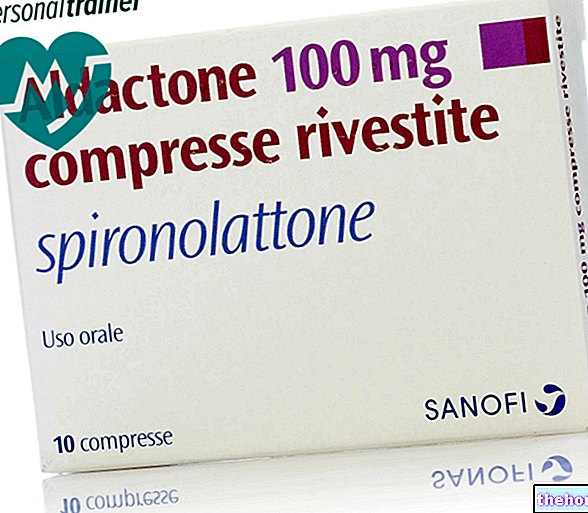Active ingredients: Ioflupane
DaTSCAN 74 MBq / ml solution for injection
Why is Datscan used? What is it for?
DaTSCAN contains the active substance ioflupane (123I), which is used to help identify (diagnose) diseases of the brain. It belongs to a group of medicines called 'radiopharmaceuticals', which contain a small amount of radioactivity.
- When a radiopharmaceutical is injected, it accumulates for a short time in an organ or part of the body.
- Since it contains a small amount of radioactivity, its presence can be detected from outside the body using special cameras.
- These can provide an image called a scan. The scan will show exactly where the radioactivity is within the organ and body. All of this will give the doctor valuable insights into how that organ is functioning.
When DaTSCAN is injected into an adult, it is carried around the body in the blood and accumulates in a small area of the brain. In this "area of the brain, alterations occur in the case of:
- Parkinsonism (including Parkinson's disease) e
- Lewy body dementia.
The scan allows the doctor to obtain information about the changes that have occurred in this area of the brain. The information obtained from the scan can help the doctor diagnose the disease and decide on possible treatment.
You are exposed to a small amount of radioactivity while using DaTSCAN. This exposure is less than that expected for some types of radiographs. Your doctor and nuclear medicine specialist have assessed the clinical benefit of this test performed with a radiopharmaceutical is greater than the risk created by exposure to these small amounts of radiation.
This medicine is for diagnostic use only, i.e. it is only used to identify diseases.
Contraindications When Datscan should not be used
Do not use DaTSCAN
- if you are allergic to ioflupane or any of the other ingredients of this medicine (listed in section 6)
- if you are pregnant
Precautions for use What you need to know before taking Datscan
Talk to your nuclear medicine doctor before you are given DaTSCAN if you have moderate or severe liver or kidney problems.
Children and adolescents
DaTSCAN is not recommended for children between the ages of 0 and 18.
Interactions Which medications or foods may change the effect of Datscan
Tell your nuclear medicine doctor if you are taking or have recently taken any other medicines. Some drugs and substances can affect the way DaTSCAN works, including:
- buproprion (used to treat depression (sadness)
- benzatropine (used to treat Parkinson's disease)
- mazindole (reduces appetite, used in the treatment of obesity)
- sertraline (used to treat depression (sadness)
- methylphenidate (used to treat hyperactivity in children and narcolepsy (excessive sleepiness)
- phentermine (reduces appetite, used in the treatment of obesity)
- amphetamine (used to treat hyperactivity in children and narcolepsy (excessive sleepiness); it is also a narcotic)
- cocaine (sometimes used as an anesthetic for nasal surgeries; it is also a narcotic)
Some medicines can reduce the quality of the image obtained. Your doctor may ask you to stop taking them for a short time before taking DaTSCAN.
Warnings It is important to know that:
Pregnancy and breastfeeding
Do not use DaTSCAN if you are pregnant or if there is a possibility that you are pregnant, as the baby may receive doses of radioactivity. Please inform the nuclear medicine specialist of this eventuality. The advisability of using alternative techniques that do not use radioactivity should always be considered.
If you are breastfeeding, your doctor may delay the use of DaTSCAN or ask you to stop breastfeeding. It is not known whether ioflupane (123I) passes into breast milk.
- You should not breastfeed your baby for 3 days after the administration of DaTSCAN.
- Replace breastfeeding with formula milk. Breast milk should be withdrawn at regular intervals and thrown away.
- You will have to continue following this procedure for 3 days, until the radioactivity is no longer present in the body.
Driving and using machines
DaTSCAN has no known influence on the ability to drive and use machines.
DaTSCAN contains 5% alcohol (ethanol) by volume. Each serving contains up to 197 mg of alcohol, which is approximately 5 ml of beer or 2 ml of wine. This is harmful to alcohol sufferers and must be taken into consideration in pregnant or lactating women, children and high-risk groups, such as patients with liver disease or epilepsy. Tell your doctor if any of these apply to you.
Dosage and method of use How to use Datscan: Dosage
There are strict laws regarding the use, handling and disposal of radioactive material.
DaTSCAN should always be used in a hospital or similar place. It must be handled and administered only by trained and qualified personnel, able to use it in safe conditions.
The staff will give you all the instructions to follow for the safe use of this medicine. The nuclear medicine specialist will decide the best dose for you.
Before receiving DaTSCAN, your doctor will ask you to take some tablets or liquids that contain iodine, to prevent radioactivity from building up in your thyroid. It is important that you take your tablets or liquid following your doctor's instructions carefully.
DaTSCAN is given by injection, usually into a vein in the arm. The recommended dose of radioactivity administered by injection is between 111 and 185 MBq (185 MBq (megabecquerel or MBq is the unit of measurement of radioactivity). A single injection is sufficient. Photographic images are usually acquired between 3 and 6 hours after the injection of DaTSCAN.
Overdose What to do if you have taken too much Datscan
Since DaTSCAN is administered by a doctor under close supervision, it is unlikely that you will receive an excessive dosage. Your doctor will advise you to take a large amount of fluids to help your body eliminate the medicine. You will need to be especially careful when urinating, your doctor will give you specific instructions. This is a normal procedure with medicines like DaTSCAN.
Any residue of ioflupane (123I) that remains in the body naturally loses its radioactivity.
If you have any further questions on the use of this medicine, ask the nuclear medicine doctor in charge of the test.
Side Effects What are the side effects of Datscan
Like all medicines, DaTSCAN can cause side effects, although not everybody gets them
. The frequency of side effects is as follows:
Common: may occur in 1 in 10 people
- Headache
Uncommon: may affect up to 1 in 100 people
- Increased appetite
- Dizziness
- Alteration of taste
- Nausea
- Dry mouth
- Dizziness
- Brief sensation of irritation similar to ants crawling on the skin (tingling)
- Severe pain at the time of injection. This has been reported among patients where DaTSCAN is injected into a small vein.
Not known: frequency cannot be estimated from the available data.
- Hypersensitivity (allergy)
The amount of radioactivity in the body resulting from DaTSCAN is very small and will be eliminated in a few days, without the need for special precautions.
Reporting of side effects
If you get any side effects, talk to your nuclear medicine doctor. This includes any possible side effects not listed in this leaflet. You can also report side effects directly via the national reporting system listed in Annex V *. By reporting side effects you can help provide more information on the safety of this medicine.
Expiry and Retention
You will not need to store this medicine. This medicine is stored under the responsibility of the specialist and in appropriate premises. The storage of radiopharmaceuticals will take place in accordance with national regulations on radioactive products.
The following information is intended for the specialist only:
- Keep this drug out of the sight and reach of children.
- Do not store above 25 ° C.
- Do not freeze.
Do not use this medication after the expiry date which is stated on the carton and vial after EXP. The expiry date refers to the last day of the month indicated. Hospital staff will ensure that the product is stored and disposed of correctly and that is not used after the expiration date stated on the label.
Deadline "> Other information
What DaTSCAN contains
- The active ingredient is ioflupane (123I). Each mL of solution contains ioflupane (123I) 74 MBq at the reference date and time (0.07 to 0.13 μg / mL of ioflupane).
- The other ingredients are acetic acid, sodium acetate, ethanol and water for injections.
Description of what DaTSCAN looks like and contents of the pack
DaTSCAN is a colorless 2.5 or 5 ml solution for injection and is sold in a single 10 ml colorless glass vial sealed with a rubber closure and metal cap.
Source Package Leaflet: AIFA (Italian Medicines Agency). Content published in January 2016. The information present may not be up-to-date.
To have access to the most up-to-date version, it is advisable to access the AIFA (Italian Medicines Agency) website. Disclaimer and useful information.
01.0 NAME OF THE MEDICINAL PRODUCT -
DATSCAN 74 MBQ / ML SOLUTION FOR INJECTION
02.0 QUALITATIVE AND QUANTITATIVE COMPOSITION -
Each mL of solution contains ioflupane (123I) 74 MBq at the reference date and time (0.07 to 0.13 mcg / mL of ioflupane).
Each 2.5 mL single-dose vial contains 185 MBq of ioflupane (123I) (specific activity range 2.5 to 4.5 x 1014 Bq / mmol) at the reference date and time.
Each 5 mL single-dose vial contains 370 MBq of ioflupane (123I) (specific activity range 2.5 to 4.5 x 1014 Bq / mmol) at the reference date and time.
Excipients:
This medicinal product contains 39.5 g / l of ethanol.
For the full list of excipients, see section 6.1.
03.0 PHARMACEUTICAL FORM -
Injectable solution.
Clear colorless solution.
04.0 CLINICAL INFORMATION -
04.1 Therapeutic indications -
Medicinal product for diagnostic use only.
DaTSCAN is indicated to detect the loss of functional dopaminergic neuronal endings in the striatum:
• Of adult patients with clinically uncertain Parkinsonian Syndromes, in order to facilitate the differentiation of Essential Tremor from Parkinsonian Syndromes related to idiopathic Parkinson's disease, plurisystemic atrophy and progressive supranuclear palsy.
DaTSCAN does not allow discrimination between Parkinson's disease, multiple system atrophy and progressive supranuclear palsy.
• In adult patients, to help differentiate probable Lewy body dementia from Alzheimer's disease.
DaTSCAN does not discriminate between Lewy body dementia and Parkinson's disease dementia.
04.2 Posology and method of administration -
Before administration, ensure that adequate resuscitation facilities are available.
DaTSCAN should only be used in adult patients followed by physicians experienced in the treatment of movement disorders and / or dementia. DaTSCAN must only be used by qualified personnel in possession of the appropriate authorizations for the use and handling of radionuclides inside specific clinical facilities.
Dosage
Clinical efficacy has been demonstrated over the interval between 111 and 185 MBq. Do not exceed 185 MBq and do not use when activity is less than 110 MBq.
Patients should undergo a preventive thyroid blocking treatment to minimize the absorption of radioactive iodine by the thyroid itself, for example by oral administration of approximately 120 mg of potassium iodide 1-4 hours before injection and again 12-24 hours after the injection of DaTSCAN.
Special populations
Renal and hepatic insufficiency
No formal studies have been conducted in patients with significant renal or hepatic impairment. No data are available (see section 4.4).
Pediatric population
The safety and efficacy of DaTSCAN in children aged 0 to 18 years have not been established.
No data are available.
Method of administration
For intravenous use.
DaTSCAN must be used undiluted. To minimize possible pain at the injection site during administration, a slow intravenous injection (not less than 15 - 20 seconds) into a vein in the arm is recommended.
It is necessary to perform a SPECT between three and six hours after the injection. The acquisition of the images must take place using a gamma camera equipped with a high resolution collimator and calibrated using the 159 keV photopeak and an energy window of ± 10 %. The angular sampling should preferably not be less than 120 images over 360 degrees.
For high resolution collimators the rotation radius must be constant and chosen as small as possible (typically 11 - 15 cm). Experimental studies with a striatal phantom suggest that in order to obtain optimal images the size of the matrix and the zoom factors must be selected to give a pixel size of 3.5 - 4.5 mm for the systems currently in use. A minimum of 500,000 counts must be collected for optimal images. Normal images are characterized by two symmetrical areas with increasing uptake of equal intensity. Abnormal images are either asymmetrical or symmetrical with different intensity and / or loss of uptake intensity.
04.3 Contraindications -
- Hypersensitivity to the active substance or to any of the excipients.
- Pregnancy (see section 4.6).
04.4 Special warnings and appropriate precautions for use -
If hypersensitivity reactions occur, administration of the medicinal product should be discontinued immediately and intravenous treatment instituted if necessary.
Resuscitation medications and aids (e.g. endotracheal tube and respirator) should be readily available.
This radiopharmaceutical should only be received, used and administered by authorized personnel in designated clinical facilities. The receipt, storage, use, transfer and disposal must be subject to the regulations and adequate authorizations of competent local bodies.
For each patient, the exposure to ionizing radiation must be justified on the basis of the possible benefits. The activity administered must be such that the resulting radiation dose is the lowest possible in relation to the diagnostic result to be obtained.
No formal studies have been conducted in patients with significant renal or hepatic impairment. In the absence of data, DaTSCAN is not recommended in cases with moderate to severe renal or hepatic impairment.
This medicinal product contains 39.5 g / l 5% ethanol (alcohol), up to 197 mg per dose, equivalent to 5 ml of beer or 2 ml of wine. Harmful for those suffering from alcoholism. This should be taken into account in the case of high-risk groups, such as patients with liver disease or epilepsy.
04.5 Interactions with other medicinal products and other forms of interaction -
No drug interaction studies have been performed in humans.
Ioflupane binds to the dopamine carrier. Medicinal products that form a high affinity bond to the dopamine vector may therefore interfere with the diagnosis made by DaTSCAN. These include amphetamine, benzatropine, buproprion, cocaine, mazindol, methylphenidate, phentermine and sertraline.
Medicinal products that do not interfere with SPECT images obtained by DaTSCAN have been shown in clinical studies include amantadine, trihexyphenidyl, budipine, levodopa, metoprolol, primidone, propranolol and selegiline. Interference with the SPECT images obtained by DaTSCAN by dopamine agonists and antagonists acting on post-synaptic dopamine receptors is not expected so their administration can continue if desired. In animal studies it has been shown that Medicines that do not interfere with the SPECT images obtained by DaTSCAN include pergolide.
04.6 Pregnancy and breastfeeding -
Women of childbearing potential
When it is necessary to administer a radioactive medicine to women of childbearing potential, information about possible pregnancy should always be obtained. Any woman who has missed a period must be regarded as pregnant until proven otherwise.
When there is an uncertain situation, the radiation to which it is exposed must be the minimum acceptable to obtain satisfactory SPECT images. The advisability of using alternative techniques that do not use ionizing radiation should always be considered.
Pregnancy
Reproductive toxicity studies in animals have not been conducted. The methods that use radionuclides used on pregnant women generate radiation involving the fetus. The administration of 185 MBq of ioflupane (123I) implies an absorption by the uterus of a dose of 3.0 mGy. DaTSCAN is contraindicated in pregnancy (see section 4.3).
Feeding time
It is not known whether ioflupane (123I) is excreted in human milk. Before administering a radioactive product to a nursing woman, the possibility of delaying the investigation until the woman has finished breastfeeding should be considered and carefully considered whether the most appropriate radiopharmaceutical has been chosen, taking into account the secretion of radioactivity in the Breast milk. If administration is deemed necessary, breastfeeding should be interrupted for 3 days and replaced with formula feeding. During this period, breast milk should be withdrawn at regular intervals and withdrawn milk discarded.
Fertility
No fertility studies have been performed. No data are available.
04.7 Effects on ability to drive and use machines -
DaTSCAN has no known influence on the ability to drive and use machines.
04.8 Undesirable effects -
Summary of the safety profile
No serious adverse reactions related to the administration of DaTSCAN have been reported.
Tabulated summary of adverse reactions
The frequency of adverse reactions is defined as follows:
very common (≥1 / 10); common (≥1 / 100,
Disorders of the immune system
Not known: hypersensitivity
Metabolism and nutrition disorders
Common: increased appetite
Nervous system disorders
Common: headache, tingling (paraesthesia)
Ear and labyrinth disorders
Common: dizziness
General disorders and administration site conditions
Uncommon: Pain at the injection site (severe pain following administration into small veins)
Exposure to ionizing radiation is related to cancer induction and the potential for hereditary defects. Since most nuclear medicine diagnostic investigations are performed with low radiation doses, below 20 mSv, a low probability of these events is expected. The effective dose is 4.35 mSv when the maximum recommended activity of 185 MBq is administered.
04.9 Overdose -
In case of radioactivity overdose it is recommended to induce an increase in diuresis and defecation in order to minimize the radiation dose absorbed by the patient. Precautions should be taken to avoid contamination with radioactivity removed from the patient using these methods.
05.0 PHARMACOLOGICAL PROPERTIES -
05.1 "Pharmacodynamic properties -
Pharmacotherapeutic group: diagnostic radiopharmaceuticals central nervous system. ATC code: V09AB03.
Since the injected amounts of ioflupane are low, no pharmacological effects are expected following intravenous administration of DaTSCAN at the recommended dose.
Ioflupane is a cocaine analogue. Animal studies have shown that ioflupane forms a high affinity bond with the pre-synaptic dopamine vector and thus radiolabelled ioflupane (123I) can be used as a replacement marker to examine the integrity of nigrostriatal dopaminergic neurons. Ioflupane forms a bond. also with the serotonin vector on 5-HT neurons but with a lower binding affinity (about 10 times lower).
There is no clinical experience with any types of tremor other than essential tremor.
Clinical studies conducted in patients with Lewy body dementia
In a pivotal clinical study, which included the evaluation of 288 subjects with Lewy body dementia (DLB) (144 subjects), Alzheimer's disease (124 subjects), vascular dementia (9 subjects) or other (11 subjects), Results of an independent, blinded visual evaluation of the images obtained with DaTSCAN were compared with the clinical diagnosis established by physicians experienced in the treatment and diagnosis of dementias. The clinical classification into the respective dementia group was based on a standardized and comprehensive clinical and neuropsychiatric assessment. Values related to the sensitivity of DaTSCAN in determining probable DLB versus non-DLB ranged from 75.0% to 80.2% and specificity from 88.6% to 91.4%. The positive predictive value ranged from " 78.9% to 84.4%, while the negative predictive value was between 86.1% and 88.7%. The analyzes in which both patients with possible DLB and those with probable DLB were compared with non-DLB dementia patients demonstrated DaTSCAN sensitivity values between 75.0% and 80.2% and specificity between 81.3% and 83.9%, when patients with possible DLBs were entered as non-DLB patients. Sensitivity ranged from 60.6% to 63.4% and specificity from 88.6% to 91.4% when patients with possible DLB were entered as DLB patients.
05.2 "Pharmacokinetic properties -
Ioflupane (123I) disappears from the blood immediately after intravenous injection; only 5% of the administered activity remains in the blood for up to 5 minutes after injection. Uptake by the brain is very rapid, reaching 7% of the activity injected 10 minutes after injection to decrease to 3% after 5 hours. About 30% of the total radioactivity present in the brain is attributed to the uptake of the striatum. At 48 hours after injection, approximately 60% of the injected radioactivity is excreted in the urine, and approximately 14% in the faeces.
05.3 Preclinical safety data -
Acute toxicity studies using ioflupane at doses of 0.06 mg / kg-6,500 times the maximum single dose used in humans (70 kg) based on body weight, conducted in mice or rabbits have not shown association with mortality. nor showed systemic toxicity. In two-week repeat-dosing studies in mice or rabbits, where the daily dose was 0.6 mg / kg of ioflupane - more than 65,000 times the maximum single dose used in humans (70 kg) based on body weight, no toxicity was found. Behavioral effects due to pharmacological activity were observed during these studies. Reproductive toxicity studies were not performed. Ioflupane did not show mutagenic potential during both in vitro and in vivo mutagenicity studies. carcinogenic potential of ioflupane.
06.0 PHARMACEUTICAL INFORMATION -
06.1 Excipients -
Acetic acid
Sodium acetate
Ethanol
Water for injections.
06.2 Incompatibility "-
Not relevant.
06.3 Period of validity "-
2.5 ml vial: 7 hours from the reference date and time declared on the label (35 hours from the end of production).
Vial 5 ml: 20 hours from the reference date and time declared on the label (48 hours from the end of production).
06.4 Special precautions for storage -
Do not store above 25 ° C. Do not freeze.
06.5 Nature of the immediate packaging and contents of the package -
2.5 or 5 ml solution in a single colorless 10 ml glass vial sealed with a rubber closure and metal cap.
Pack of 1 vial.
Not all pack sizes may be marketed.
06.6 Instructions for use and handling -
Normal precautions for handling radioactive materials should be observed.
After use, all materials used in the preparation and administration of radiopharmaceuticals, including any unused product and its container, must be decontaminated or treated as radioactive waste and disposed of according to specific regulations established by the local competent authority. Contaminated material must be disposed of as radioactive waste via an authorized route.
07.0 HOLDER OF THE "MARKETING AUTHORIZATION" -
GE Healthcare Limited - Little Chalfont, Bucks HP7 9NA - United Kingdom
08.0 MARKETING AUTHORIZATION NUMBER -
EU / 1/00/135/001 (2.5 ml), AIC: 034959015
EU / 1/00/135/002 (5 ml), AIC: 034959027
09.0 DATE OF FIRST AUTHORIZATION OR RENEWAL OF THE AUTHORIZATION -
Date of first authorization: 27 July 2000
Date of the last renewal:
10.0 DATE OF REVISION OF THE TEXT -
11.0 FOR RADIO DRUGS, COMPLETE DATA ON THE INTERNAL RADIATION DOSIMETRY -
Iodine-123 has a physical half-life of 13.2 hours. It decays by emitting gamma radiation with a predominant energy of 159 keV and X-rays at 27 keV.
The radiation doses absorbed by an adult patient (70 kg) following intravenous injection of ioflupane (123I) are listed below. The values were calculated assuming emptying of the bladder at intervals of 4.8 hours and adequate blockage of the thyroid (it is known that Iodine -123 emits Auger electrons). Frequent emptying of the bladder after administration should be encouraged to minimize radiation exposure.
The effective dose (E) resulting from the administration of 185 MBq of DaTSCAN per injection is 4.35 mSv (for a 70 kg adult). The data listed above are valid under conditions of normal pharmacokinetic behavior. When renal or hepatic function is impaired, the effective dose and the dose of radiation administered to the organs may be increased.
12.0 FOR RADIO DRUGS, FURTHER DETAILED INSTRUCTIONS ON EXEMPORARY PREPARATION AND QUALITY CONTROL -
Unused medicine and waste derived from this medicine must be disposed of in accordance with local regulations. See also section 6.6.




























